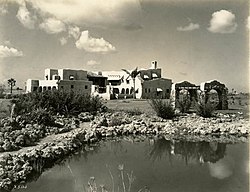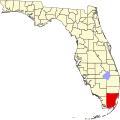Miami Springs, Florida | |
|---|---|
| City of Miami Springs | |
| Motto: At the Heart of it All! | |
 Location in Miami-Dade County and the state of Florida | |
 U.S. Census Bureau map showing city limits | |
| Coordinates: 25°49′11″N80°17′28″W / 25.81972°N 80.29111°W | |
| Country | |
| State | |
| County | |
| Incorporated | August 23, 1926 |
| Government | |
| • Type | Council-Manager |
| • Mayor | Maria Puente Mitchell |
| • Vice Mayor | Title is held through rotation |
| • Councilmembers | Jorge Santin Jacky Bravo Walter Fajet Victor Vazquez |
| • City Manager | Interim Manager Tammy Romero |
| • City Clerk | Erika Gonzalez-Santamaria |
| Area | |
• Total | 2.98 sq mi (7.73 km2) |
| • Land | 2.88 sq mi (7.46 km2) |
| • Water | 0.11 sq mi (0.27 km2) |
| Elevation | 6 ft (2 m) |
| Population | |
• Total | 13,859 |
| • Density | 4,813.82/sq mi (1,858.78/km2) |
| Time zone | UTC-5 (EST) |
| • Summer (DST) | UTC-4 (EDT) |
| ZIP codes | 33166, 33142 (Miami) |
| Area codes | 305, 786, 645 |
| FIPS code | 12-45200 [3] |
| GNIS feature ID | 0286762 [4] |
| Website | www |

Miami Springs is a city in Miami-Dade County, Florida, United States. The city is part of the Miami metropolitan area of South Florida. As of 2020, the population recorded by the U.S. Census Bureau was 13,859.






